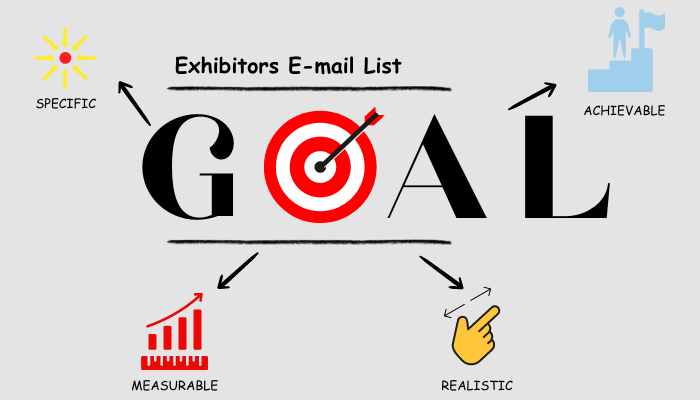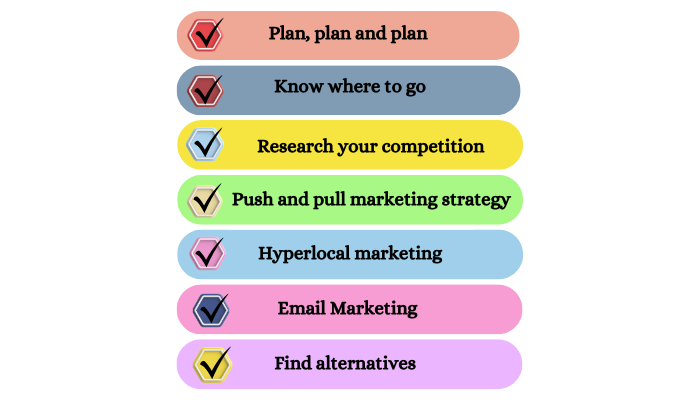Table of Contents
7 tips to get your business noticed before, during, and after a trade show!

Nothing has so far dimmed the light of trade shows and exhibitions. Small and big businesses love it for exposure and direct interaction with prospective buyers. Networking with other people in the industry during and after the event through the exhibitors database, extending the product line and company vertically, and positioning themselves as the thought leader via sessions and speaking opportunities are wholesome marketing opportunities all rolled into one.
However, attending and exhibiting at a trade show isn’t easy for a business. There are a lot of challenges and pain points that businesses face, irrespective of their size and industry. However, this can be resolved with the right approach and targeted strategy so that businesses can optimize their investment and attendance at a trade show.
Since we are addressing ways to stand out at a trade show in this article, it is important to understand the trade show challenges businesses usually face.
The planning and marketing of a trade show event start much before the event. The critical management allocates a marketing budget to attend trade shows, exhibitions, and events. This is where it all begins. If a business gets this step right, it is a battle half won. However, a detailed roadmap is indispensable to succeed at a trade show.
Let’s see where businesses go wrong and fall short of their expectations:
1. Not having a purpose or common objective:

Why does your business want to attend a trade show? Where does this fit into the marketing budget? Marketing is a cost center for a business. So, does it align with the sales department to attend a trade show? What are the revenue projections, and can the sales be fruitful to cover the costs of attendance and bring in some profits? Or rather, is it better to utilize an exhibitors email list to reach out to the exhibitors and attendees and funnel this money to the sales and training department?
2. Not selecting an industry-relevant and specific trade show:
Businesses want to be everywhere simultaneously. They want to be noticed, go all out of their way with marketing gimmicks for brand recall, and wouldn’t want to miss out on an opportunity where they could get leads and close deals. Attending a trade show seems better and more straightforward than reaching out to buyers and potential business collaborators than digging into an expo list. Still, the former also costs businesses an arm and a leg.
Based on their industries, businesses can zero in on a trade show they would want to prioritize. There are a few questions that can be asked to finalize a trade show:
- Are you in a B2B or B2C vertical? Is the trade show meant for your vertical?
- Is your competitor going to be there?
- Is it covered by the media extensively?
- Are the attending audience decision-makers? Is the footfall lucrative enough to spend money on a booth?
- How many booths and stalls were there last year?
- How much of an increase has been in the booth price and floor plan? Is it worth spending that money?
This is when an exhibitors database can come in handy and enable business leaders to decide. Such databases often include a trade show email list comprising details like the number of attendees, names of exhibitors, floor pricing, and estimates of revenue generated. Businesses can project their numbers and make an informed decision based on it.
3. Undermining the spending:
To the untrained eye, a trade show’s main expense would be renting out the floor space and finalizing the booth design. However, experts know that this is only the tip of the iceberg. Once you are in, you won’t want to miss out on a place in the interactive session and register your company as a speaker. Training, marketing collateral, logistics, and warehousing costs are attached to a trade show and can be massive. Additionally, if it is a hybrid event, you need to take the sound system and internet costs into account as well.
Referring to an exhibitors list from last year can bring in more clarity and help plan better. It is crucial to identify the channels where a business can spend money and avoid it. For instance, the need to invest in a hybrid channel can be eliminated if the numbers don’t meet expectations. Similarly, businesses can track competitors’ marketing strategies by validating a conference list. Did a competitor buy a speaker slot? Was it worth the engagement and investment? All this spending should be accounted for before taking a plunge, especially for small businesses.
4. Not planning and changing the master plan too often:
Ever heard of ‘too many cooks spoil the broth?’ Well, many businesses are guilty of it. While there is no harm in taking everybody along, the sooner a strategy is devised and agreed upon, the better. Of course, it can be tweaked in parts as they move along, but the broader framework should remain the same, and the sales staff should train themselves based on that.
Business executives can learn from the exhibitors database and analyze attendees’ time at a booth to formulate a strategy and create marketing collaterals along those lines.
5. Not training sales staff:

While scientists have settled the age-old debate about what came first, egg or chicken, the conversation about whether such trade events or exhibitions are a marketing show or up the sales teams’ alley is still up for debate. Some marketing experts think that companies should hire an external professional team to work the booth that is more equipped to draw engagement and better at setting a narrative. However, business a trade show presence is what more than 80 percent of visitors take home, and 85 per cent of a show’s success depends on the booth staff.
Regardless of the route a business takes to man its booth at a trade show, it must get the basics right. Be it sales staff or an outsourced team, they should be familiar with the product or services being offered. At any cost, a sales team is indispensable at a trade show. It might not be able to draw a flashy impression, but what it lacks can be made up with its product knowledge.
6. Not following up with the leads:
It is a surprise that despite such tech advancements, companies still struggle with this. There are lead-capturing apps and scanners for business cards. Digital business cards can also be air-dropped. While 81% of the exhibitors list follow-up with the leads collected, only 6% are confident that they can successfully close the deals with them.
Also read: 51 B2B Lead Generation Tactics and Strategies For 2024
7. Not having a well-rounded marketing strategy:

A clear, pre-defined marketing strategy can help businesses go a long way. They can utilize resources well and course-correct if it comes to that. Yet, often, the marketing department isn’t part of the planning stage, and as a result, the message and brand positioning never align and are fragmented.
Now that we have talked about the challenges businesses face for a successful trade show at length, it is time to know the solutions that can make a difference and enable them to have an effective and memorable presence that is worth the investment!
7-Pointer Checklist for Trade Show Success

A trade show marketing strategy should start from the planning stage and go well beyond the post-event follow-ups.
1. Plan, plan and plan:
Start with the objective. Ask the right questions, review the budget and be clear with the expectations. Utilize last year’s expo list, dig for relevant data and carve out an outline to beat your competition. Planning for the trade shows you want to attend at the beginning of the financial year is always better.
2. Know where to go:
It is not essential to attend every show. It is important to attend the right one. Skipping out a few ones doesn’t mean you lose out on potential leads. A trade show email list is ideal for businesses to extend their network and seek out possible opportunities. They can also prioritize their presence at the trade shows by using exhibitors’ data and finding out where their competitors might be.
3. Research your competition:
Don’t know where to start? Exhibitors database would be a good place to get industry-specific data and start with benchmarking. Finding out what your competition did for the booth design or their booth engagement strategy can be a brilliant way to outsmart them.
4. Push and pull marketing strategy:
Businesses need to recognize the importance and place of push and pull marketing in trade show success. While a trade show is a brilliant way to push yourself out there in prospective buyers’ eyes, email marketing, social media, SEO, and content marketing will pull them in. Hence, finding the right balance is the key. While a trade show or a billboard can cause a dent in your marketing strategy, pull marketing comes to the rescue. Costing a fraction and reaching out to hundreds and thousands of people simultaneously is non-negotiable if you want to make the most of your time and effort at a trade show. You can develop a simple website for FAQs or pain points that the buyers deal with, and how does your product or service address it? Or maybe do one better by creating micro-content and sending them before the event using the exhibitors email list to create familiarity.
5. Hyperlocal marketing:
Hyperlocal marketing has been an integral aspect of SEO. It is the part where the buyers or consumers search for results using ‘near me’ and is location-based. The importance of hyperlocal marketing for success in trade shows can’t be stressed enough for a B2C or D2C business. Imagine your prospective buyers are searching for a trade show near them to explore the products or services you are selling, and you are nowhere to be found!
6. Email Marketing as a pre-trade show and follow-up measure:
Emails are a brilliant way to directly approach a potential networking opportunity or buyer. However, this shouldn’t just be used as a follow-up tool. Businesses should use a trade show email list and social media channels to announce their presence at a particular trade show. The salespeople can also utilize this channel to grow connections and establish trust. An email requesting an in-person meeting or ‘How should we serve you better’ can create anticipation and improve the interaction at the booth. For post-follow-up, the sales cadence offering support, manual, education material, offers, and promotion materials can be sent. However, it needs to be ensured that the follow-up is generally non-annoying and doesn’t disturb the receiver, as the salespeople need to be quite persistent and follow up at least five times to seal the deal.
7. Find alternatives:
Attending a trade show or not attending it isn’t the end of the world. It is a wonderful way to build rapport and establish yourself as a brand and thought leader, but it doesn’t have to happen right away. If, as a business leader, a small business owner or a start-up founder, you are facing a cash crunch and need to redirect funds to other departments that can help you survive, that should be your first choice. As far as reaching out to the exhibitors and prospective buyers is concerned, a trade show email list and exhibitors database can do that and help you be out there.
Hope these tips help businesses to find success and mark a strong presence. If you want to understand how an exhibitors list can help you succeed at a trade show or an exhibition, you are at the right place! Click here to download your industry-specific sample and get started, or contact us to schedule a demo call.

How to Dominate WHX and WHX Labs 2026 Like a Pro
Executive Summary / Key Takeaways: 12% increase in pavilion space for Germany, China, and Korea at WHX and WHX Labs 2026 signals market dominance 30% increase in dual-presence exhibitors shows scaling from...
